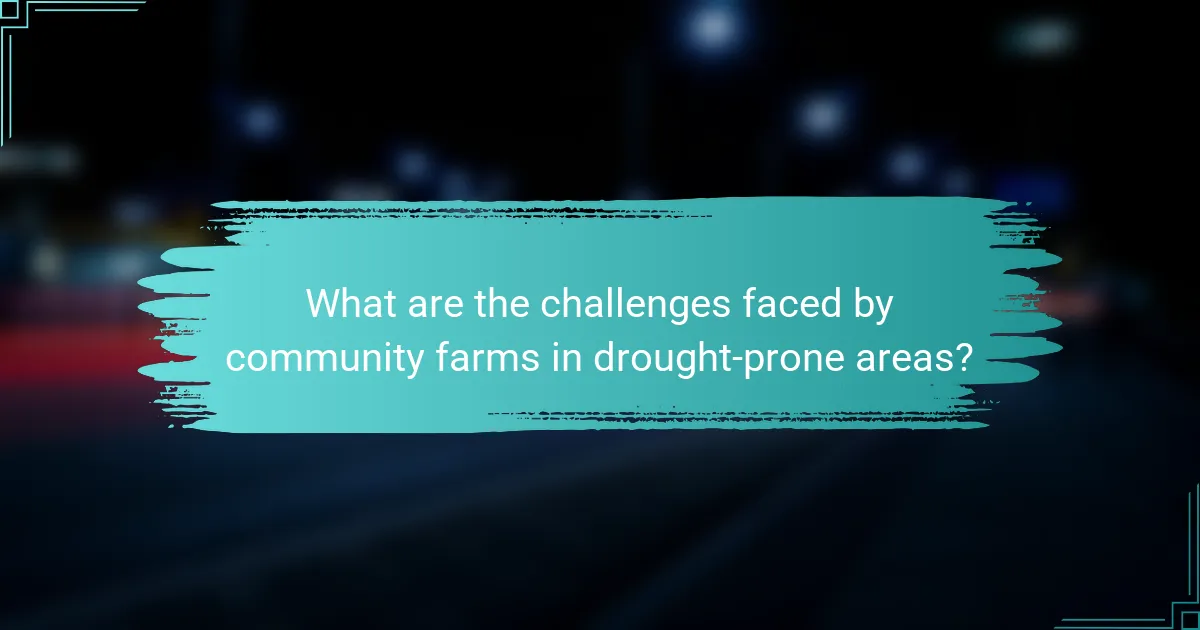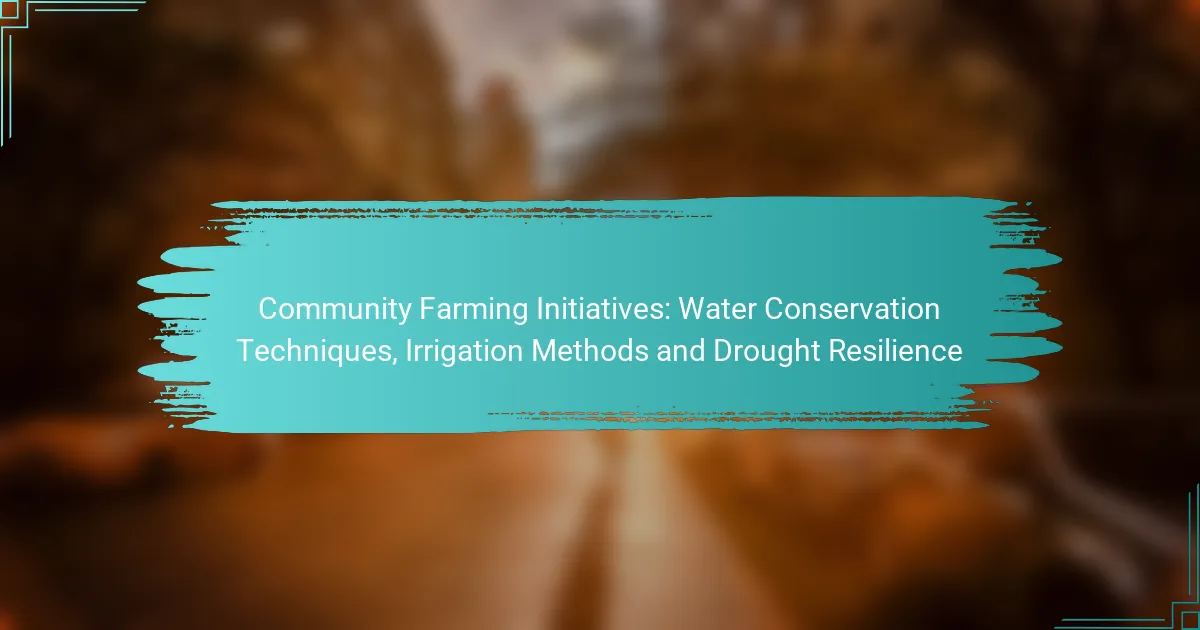Community farming initiatives play a crucial role in promoting water conservation techniques and enhancing drought resilience. By optimizing irrigation methods tailored to local conditions, these initiatives not only preserve vital water resources but also boost crop yields and sustainability. Implementing effective strategies allows communities to maintain agricultural productivity even in the face of water shortages, ensuring food security and economic stability.

What are effective water conservation techniques for community farming?
Effective water conservation techniques for community farming include methods that optimize water use and enhance resilience to drought. These techniques not only help in preserving water resources but also improve crop yields and sustainability.
Rainwater harvesting systems
Rainwater harvesting systems capture and store rainwater for agricultural use, reducing reliance on traditional water sources. These systems can be as simple as barrels placed under downspouts or more complex setups involving cisterns and filtration systems.
To implement rainwater harvesting, consider the average rainfall in your area and the size of the catchment area. A well-designed system can collect thousands of liters of water annually, significantly benefiting community farms during dry spells.
Drip irrigation methods
Drip irrigation delivers water directly to the plant roots through a network of tubing and emitters, minimizing evaporation and runoff. This method is highly efficient, using up to 50% less water than traditional irrigation methods.
When setting up a drip irrigation system, ensure proper emitter placement and adjust flow rates based on plant needs. Regular maintenance is crucial to prevent clogging and ensure optimal performance.
Soil moisture management
Soil moisture management involves monitoring and maintaining the right moisture levels in the soil to support plant growth. Techniques include using moisture sensors, soil testing, and adjusting irrigation schedules based on moisture readings.
Implementing soil moisture management can lead to better water use efficiency. Aim for a balance where the soil remains moist but not waterlogged, which can harm plant roots.
Mulching practices
Mulching involves covering the soil surface with organic or inorganic materials to retain moisture, suppress weeds, and regulate soil temperature. Common materials include straw, wood chips, and plastic sheeting.
Apply a layer of mulch around plants to reduce evaporation and improve soil health. A thickness of 5-10 cm is generally effective, but adjust based on local conditions and plant types.
Use of drought-resistant crops
Drought-resistant crops are varieties that require less water and can thrive in arid conditions. Examples include sorghum, millet, and certain legumes, which are well-suited for regions prone to water scarcity.
When selecting crops, consider local climate and soil conditions. Incorporating these varieties into community farming can enhance resilience and reduce the overall water demand of the farm.

How can community farms implement irrigation methods?
Community farms can implement various irrigation methods to optimize water use and enhance crop resilience. Selecting the right system depends on factors such as soil type, crop needs, and local climate conditions.
Surface irrigation systems
Surface irrigation involves distributing water over the soil surface, allowing it to flow through furrows or basins. This method is often cost-effective and simple to set up, making it suitable for small-scale farms. However, it requires careful management to prevent waterlogging and ensure even distribution.
Farmers should consider the slope of their land and soil type when using surface irrigation. For example, sandy soils may require more frequent watering, while clay soils hold water longer. Regular monitoring can help optimize water application and minimize waste.
Subsurface irrigation techniques
Subsurface irrigation delivers water directly to the root zone through buried pipes or tubes. This method reduces evaporation and runoff, making it highly efficient. It is particularly beneficial in arid regions where water conservation is critical.
Implementing subsurface systems requires an initial investment in infrastructure, but the long-term savings on water and labor can be significant. Farmers should ensure proper installation and maintenance to avoid clogging and ensure consistent water delivery.
Sprinkler irrigation options
Sprinkler irrigation mimics natural rainfall by distributing water through a system of pipes and nozzles. This method is versatile and can be adapted to various field sizes and crop types. It is especially useful for areas with uneven terrain.
When choosing a sprinkler system, consider factors such as water pressure, coverage area, and the specific needs of the crops. Regular maintenance is essential to prevent leaks and ensure optimal performance. Community farms may also explore options like drip irrigation, which can further enhance water efficiency.

What are the benefits of drought resilience in community farming?
Drought resilience in community farming enhances the ability to withstand water shortages, leading to more stable food production and economic security. By implementing effective water conservation techniques, communities can maintain agricultural productivity even during dry spells.
Improved crop yields
Implementing drought resilience strategies can significantly improve crop yields. Techniques such as rainwater harvesting and drip irrigation allow farmers to optimize water use, ensuring that plants receive adequate moisture without waste. This can lead to yield increases of 20-50% compared to traditional methods in arid regions.
Farmers should consider selecting drought-resistant crop varieties, which are specifically bred to thrive in low-water conditions. This approach not only boosts yields but also reduces reliance on chemical inputs, promoting a more sustainable farming practice.
Enhanced soil health
Drought resilience practices contribute to enhanced soil health by promoting better moisture retention and nutrient availability. Techniques such as cover cropping and mulching help prevent soil erosion and improve organic matter content, which is crucial for maintaining soil structure and fertility.
Regularly testing soil health can guide farmers in making informed decisions about amendments and crop rotations. Healthy soil supports robust plant growth, which is essential for achieving consistent yields during periods of drought.
Increased community sustainability
Building drought resilience fosters increased sustainability within farming communities by reducing dependence on external water sources and enhancing local food security. When communities adopt collective water management practices, they can share resources and knowledge, leading to more efficient water use.
Community-supported agriculture (CSA) models can further strengthen local economies by connecting farmers directly with consumers. This not only promotes local food systems but also encourages investment in sustainable practices that benefit the entire community.

What criteria should be considered for selecting irrigation systems?
When selecting irrigation systems, consider factors such as soil type, water availability, and crop requirements. These criteria help ensure that the chosen system is efficient, sustainable, and tailored to the specific agricultural context.
Soil type and topography
Soil type and topography significantly influence irrigation system selection. Sandy soils drain quickly, requiring more frequent watering, while clay soils retain moisture longer, necessitating less frequent irrigation. Additionally, hilly or uneven terrain may require specialized systems like drip irrigation to ensure even water distribution.
Evaluate the slope of the land as well; steep areas may lead to runoff, making it essential to choose systems that minimize water loss. Conducting a soil test can provide insights into moisture retention and nutrient levels, guiding the selection process.
Water availability and quality
Assessing water availability and quality is crucial for effective irrigation. Consider the source of water, such as rivers, lakes, or groundwater, and ensure it meets quality standards for agricultural use. Contaminated water can harm crops and soil health, so testing for pollutants is advisable.
Additionally, evaluate the quantity of water available throughout the growing season. Regions with limited water supply may benefit from more efficient systems like drip irrigation, which delivers water directly to the plant roots, reducing waste.
Crop requirements
Understanding crop requirements is vital for selecting the right irrigation system. Different crops have varying water needs based on their growth stages and environmental conditions. For instance, leafy vegetables often require more frequent watering compared to drought-resistant crops.
Research the specific water needs of the crops being cultivated and consider using a scheduling system that aligns irrigation with these requirements. This approach can enhance crop yield and conserve water, particularly in regions prone to drought.

What are the challenges faced by community farms in drought-prone areas?
Community farms in drought-prone areas face significant challenges, primarily due to limited water resources and the increasing frequency of dry spells. These conditions can lead to reduced crop yields, increased competition for water, and higher operational costs.
Water scarcity and its impact on crop yields
Water scarcity directly affects the ability of community farms to maintain healthy crops. Insufficient irrigation can lead to stunted growth and lower yields, making it essential for farmers to adopt effective water management strategies. For instance, implementing rainwater harvesting systems can help capture and store water for dry periods.
Soil degradation and erosion
Drought conditions can exacerbate soil degradation and erosion, reducing the land’s fertility over time. Practices such as crop rotation and cover cropping can help improve soil health and retain moisture. Community farms should consider these techniques to mitigate the adverse effects of drought on their soil.
Increased operational costs
As water becomes scarcer, the costs associated with irrigation and water procurement can rise significantly. Community farms may need to invest in more efficient irrigation systems, such as drip irrigation, which can reduce water usage while maintaining crop health. Budgeting for these investments is crucial for long-term sustainability.
Community engagement and resource sharing
Building a strong community network is vital for addressing the challenges of drought. Collaborative efforts, such as sharing resources and knowledge, can enhance resilience. Community farms can organize workshops to educate members on water conservation techniques and sustainable farming practices.
